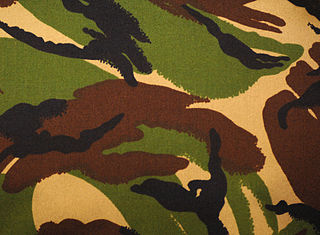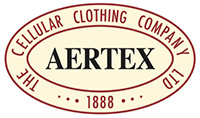This article includes a list of general references, but it lacks sufficient corresponding inline citations .(March 2011) |

Khaki drill (KD) is the British military term for a type of fabric and the military uniforms made from them. [1]
This article includes a list of general references, but it lacks sufficient corresponding inline citations .(March 2011) |

Khaki drill (KD) is the British military term for a type of fabric and the military uniforms made from them. [1]
Khaki colour uniforms were first introduced in 1848 in the British Indian Army Corps of Guides. [1] As well as the Corps of Guides, other regiments in India soon adopted the uniform and eventually it was used throughout the British military.
Khaki drill was worn as a combat uniform from 1900 to 1949 and was most often used in desert and tropical service. A variant, still referred to as khaki drill or KD, is worn by the British Armed Forces in non-combatant warm-weather countries where the British are actively serving (e.g. personnel stationed at RAF Akrotiri in Cyprus will wear any of four working variants of this uniform). Generally, KD was a series of different uniform patterns of light khaki cloth, generally cotton, first worn by British and British Empire soldiers in the Boer War. Canada developed its own pattern after the First World War, and the uniform was commonly worn in Canada, with officers again having the option of finer garments privately purchased. In the Second World War, Canadians serving in Jamaica and Hong Kong wore Canadian-pattern KD; the I Canadian Corps troops in Italy wore KD supplied in theatre by the British, generally of British, Indian, or US (War Aid) manufacture.
In the early part of the North African Campaign and the Mediterranean theatre, British troops wore KD shorts or slacks with long-sleeved Aertex-fabric shirts. The paler tan shade of KD was more suited to desert or semi-desert regions than the "dark khaki" or brown serge used in British Battledress. When the Allies moved up through Italy, however, two-piece khaki denim battledress overalls were increasingly preferred. By 1943, the KD shirt began to be replaced by a more durable cotton KD bush jacket.
In the Far East, the British found themselves at war with the Japanese while equipped with the impractical KD uniform. Shirts and trousers had to be dyed green as a temporary expedient until more suitable jungle clothing became available. A new tropical uniform in Jungle Green (JG) was quickly developed – a JG Aertex battledress blouse, a JG Aertex bush jacket (as an alternative to the blouse) and battledress trousers in JG cotton drill. In the hot and humid conditions of Southeast Asia, JG darkened with sweat almost immediately. [2] [ page needed ]
The khaki battledress was used until the late 1960s, and various uniform items in KD, JG and olive green (OG) remained on issue to soldiers serving in the Mediterranean, Middle East or tropics after the war. By the end of the 1940s, however, stocks were becoming depleted, and a new 1950-pattern tropical uniform was made available in both KD and JG. It was poorly designed, with an ill-fitting bush jacket in the much-maligned Aertex, and suspender buckles that dug into the hips when marching in full kit. Eventually the much more practical Gurkha regiments' JG shirt was copied, replacing the 1950-pattern bush jacket. All the same, troops still sought out the older, wartime, issues of the better KD, JG and OG kit.

A slouch hat is a wide-brimmed felt or cloth hat most commonly worn as part of a military uniform, often, although not always, with a chinstrap. It has been worn by military personnel from many different nations including Australia, Ireland, the United Kingdom, Canada, India, New Zealand, Southern Rhodesia, France, the United States, the Confederate States, Germany and many others. Australia and New Zealand have had various models of slouch hat as standard issue headwear since the late Victorian period.

A military uniform is a standardised dress worn by members of the armed forces and paramilitaries of various nations.

A combat uniform, also called field uniform, battledress or military fatigues, is a casual type of uniform used by military, police, fire and other public uniformed services for everyday fieldwork and combat duty purposes, as opposed to dress uniforms worn in functions and parades. It generally consists of a jacket, trousers and shirt or T-shirt, all cut to be looser and more comfortable than more formal uniforms. Design may depend on regiment or service branch, e.g. army, navy, air force, marines, etc. In the army branches, fabrics tend to come in camouflage, disruptive pattern or else green, brown or khaki monochrome, in order to approximate the background and make the soldier less visible in nature. In Western dress codes, field uniform is considered equivalent to civilian casual wear. As such, field uniform is considered less formal than service dress uniform, generally aimed at office or staff use, as well as mess dress uniform, and full dress uniform.

Imperial Japanese Army uniforms tended to reflect the uniforms of those countries who were the principal advisors to the Imperial Japanese Army at the time.

Disruptive Pattern Material (DPM) is the commonly used name of a camouflage pattern used by the British Armed Forces as well as many other armed forces worldwide, particularly in former British colonies.
The United States Army in World War II used a variety of standard and non-standard dress and battle uniforms, which often changed depending upon the theater of war, climatic environment, and supply exigencies.

The Denison smock was a coverall jacket issued to Special Operations Executive (SOE) agents, the Parachute Regiment, the Glider Pilot Regiment, Air Landing Regiments, air observation post squadrons, Commando units, and other Commonwealth airborne units, to wear over their Battle Dress uniform during the Second World War, remaining in service with the British Army until the early 1970s when it was replaced by a version in the Disruptive Pattern Material (DPM) smock. The garment was also issued as standard to the scout and sniper platoons of line infantry battalions.
The uniforms of the Canadian Armed Forces are the official dress worn by members of Canada's military while on duty.

Battledress (BD), later named the No. 5 Uniform, was the combat uniform worn by British Commonwealth and Imperial forces through the Second World War.

The uniforms of the British Army currently exist in twelve categories ranging from ceremonial uniforms to combat dress. Uniforms in the British Army are specific to the regiment to which a soldier belongs. Full dress presents the most differentiation between units, and there are fewer regimental distinctions between ceremonial dress, service dress, barrack dress and combat dress, though a level of regimental distinction runs throughout.

Service dress uniform is the informal type of uniform used by military, police, fire and other public uniformed services for everyday office, barracks and non-field duty purposes and sometimes for ceremonial occasions. It frequently consists of a jacket, trousers, dress shirt, and neck tie, along with orders, medals, and insignia. Design may depend on regiment or service branch, e.g. army, navy, air force, marines, etc. In Western dress codes, a service dress uniform is a permitted supplementary alternative equivalent to the civilian suit—sometimes collectively called undress or "dress clothes". As such, a service dress uniform is considered less formal than both full dress and mess dress uniforms, but more formal than combat uniforms.

The United States Marine Corps (USMC) prescribes several types of military uniform to distinguish its service members from other armed services, depending on the situation.

Service Dress is the style of khaki service dress uniform introduced by the British Army for use in the field from the early 1900s, following the experiences of a number of imperial wars and conflicts, including the Second Boer War. This variant of uniform continues to be worn today, although only in a formal role, as No. 2 Pattern dress.

The Royal Air Force uniform is the standardised military dress worn by members of the Royal Air Force. The predominant colours of Royal Air Force uniforms are blue-grey and Wedgwood blue. Many Commonwealth air forces' uniforms are also based on the RAF pattern, but with nationality shoulder flashes. The Royal Air Force Air Cadets wear similar uniforms.
The uniforms of the United States Army distinguish soldiers from other service members. U.S. Army uniform designs have historically been influenced by British and French military traditions, as well as contemporary U.S. civilian fashion trends. The two primary uniforms of the modern U.S. Army are the Army Combat Uniform, used in operational environments, and the Army Green Service Uniform, worn during everyday professional wear and during formal and ceremonial occasions that do not warrant the wear of the more formal blue service uniform.

Aertex was a British clothing company based in Manchester, established in 1888, and also the name of the fabric manufactured by the company. It owned the trademark for Aertex fabric, a lightweight and loosely woven cotton material that is used to make shirts and underwear.

The New Zealand Army uniform has changed over the years from that of the original Armed Constabulary of the 1800s to the modern Army Combat Uniform style in use by the majority of world armies today. While British Army influence has always been strong, distinctive New Zealand features have gradually developed. From 2013 the New Zealand Army uniform underwent a complete redesign with a new and distinctive camouflage pattern unique to the NZDF.

The Rhodesian Brushstroke is a brushstroke-type camouflage pattern used by the Rhodesian Security Forces from 1965 until its replacement by a vertical lizard stripe in 1980.

The Royal Marines uniform is the standardised military dress worn by members of the Royal Marines.
The uniforms of the Australian Army have changed significantly over the past century, although the accoutrements worn over this period have remained relatively similar. The forces of the Australian colonies and the early forces of the Commonwealth post-Federation in 1901 closely followed the uniforms of the British Army. Since then it has continued to be influenced by British but also US styles, as well as including some distinctly Australian designs, reflecting local conditions and trends.